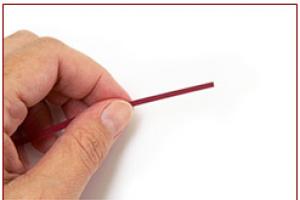There are several main designs of overhead gates, each of them has its own principles of operation. The definition of “lifting” speaks for itself - it means that door leaf rises with the help of a certain force, which can be done manually or using automation. In this article we will provide instructions for making various types such a gate.
Main types of overhead gates
Overhead gates can be divided into three main classes: roller, sectional and solid.
- Roller or roller shutter gates are a structure of narrow transverse sections (lamellas). The sections, screwing onto the shaft, open the opening. If the gate is connected to an electric drive, it can be controlled using a remote control. They are light in weight and can cover fairly wide or high openings. The gates have a modern and very neat appearance that fits into any architectural style building. Their main disadvantage is the highest cost in the overhead gate segment. Making roller gates yourself will not save much money, since the main components of the system (leaf, shaft, guides and electric drive) are almost impossible to manufacture at home.
- Sectional doors are very similar in design to roller doors, the only difference is the size of the sections. For such gates, the width of the sections ranges from 30 to 50 cm, and they move upward along special guides. The sections are connected to each other using movable fasteners. Sectional doors require extra space for a raised canvas and are often used to cover large openings. The big advantage of the system is that it can be manufactured by a person without special skills and equipment. To do this, it is important to decide on the design, calculate it, and determine the required amount of materials and tools.
- Up-and-over gates are a single piece mounted on a frame. The frame with the canvas is driven manually or using an electric drive. The gates are characterized by increased strength, burglary resistance and simple design. The canvas frame, made of a metal profile, is not subject to distortion and jamming. The door leaf can be made of any material and can decorate a garage or home. Compared to other models, one-piece overhead gates can be very inexpensive, and their independent manufacture and installation will not cause much trouble. Before starting work, it is necessary to calculate the expected weight of the canvas and make sure that lifting mechanism withstood this load.
Design and calculation of sectional doors
Choice optimal size garage doors depends on the following criteria:

Calculation of the optimal size of the opening for sectional doors For passenger car looks like this:
- Minimum opening height: 1788 + 200 = 1988 mm.
- Minimum opening width for perpendicular entry: 1942 + 700 = 2642 mm.
- Minimum opening width when entering at an angle: 1942 + 1000 = 2942 mm.
We have calculated the minimum acceptable dimensions of garage doors. When drawing up a sketch or drawing, it is more advisable to round these values to the nearest whole number. The height of the gate is rounded to 2 m, and the width to 3 m.
Selection of materials for making gates
All items must be purchased according to specification. Sandwich or metal panels, much less often - wooden slats.
A sandwich panel consists of two metal plates covered protective compounds, and insulation between them
Since the panels are connected to each other by special flexible elements, the simplest and most convenient option is to purchase a ready-made sectional sheet of the required size.
The sectional fabric at the bottom is closed with an end profile. It is covered from the sides with side linings, which provide additional rigidity and protect the end part of the gate from impact. external factors. Used as guide profiles metal channels. Metal corners are used as corner vertical profiles. The brackets are also made from metal profiles. For lifting mechanism must be purchased:
- spring;
- spring tips;
- drum;
- cable;
- suspension;
- coupling.
Selection of tools
When manufacturing and installing sectional doors, you will need a standard set of tools:
- Roulette.
- Construction level.
- Hammer.
- Construction knife.
- Pliers.
- Screwdrivers.
- Hammer.
- Drill.
- Bulgarian.
- Drill bits.
- Set of wrenches.
Personal protective equipment should also not be neglected - for work you need to purchase construction gloves and safety glasses. If the gate is of considerable height, then you need to ensure there is a stepladder.
Instructions for the manufacture and installation of sectional doors
- Before starting work, check the verticality of the walls adjacent to the opening and the geometry of the opening itself. If significant errors are found, the situation should be corrected if possible, for example, by plastering the surfaces.
- Before installing the guides, apply the bottom panel to the opening so that its edges extend behind the opening at the same distance on both sides. These distances are marked with a pencil. Next, proceed to the installation of vertical and horizontal guides, which need to be cut with a grinder into the required lengths. Holes are drilled in the walls of the opening using a drill and vertical profiles are attached using anchors according to the markings. Horizontal guides are mounted on brackets, which, in turn, are fixed to the ceiling. To prevent distortion of the structure, the profiles are placed strictly vertically or horizontally; their position is checked using a building level.
- Then the sectional canvas itself is mounted directly. At the joints of the sections of the canvas, rollers are fixed, which allow the canvas to move up and down along the guides.
- Start installing the lifting mechanism. The gate can be raised manually or electrically. We will consider all the nuances of choosing and manufacturing an automatic lifting mechanism in more detail below.
- After all the main elements of the gate are installed, handles are attached to the door leaf on both sides. The lock is usually cut into the lower section. To increase burglary resistance, two locks are sometimes installed on opposite sides of the canvas.
- Finally, a catching device is installed, which allows the door leaf to be in a half-open position, and stoppers that limit the movement of the gate when lifting.
- The gate is put into operation. A properly installed gate should move freely along the guides. In the lowered position there should be no gaps, the lock should function without the use of additional force.
Selection and installation of automation for sectional doors
There are two types automatic mechanisms, which are suitable for automating sectional doors.
- Bulk electric drive. He has high power and is designed mainly for industrial sectional doors.
- Ceiling-type electric drive. This mechanism is more suitable for a garage and is attached to the ceiling in the middle of the opening with inside. The electric drive drives the door leaf using a cable secured with a traction lever in the upper section of the door leaf.
Almost all electric drives are equipped with a safety system that prevents the blade from falling during a power outage. Various additional functions can also be useful when operating the gate:
- remote control;
- the presence of photocells that react to movement;
- presence of signal lamps.
When buying automation from well-known European brands, you will never regret your choice, because they really produce high-quality and reliable equipment. Installation of the automatic system is as follows:
- Brackets are secured to the ceiling using anchors.
- They are equipped with a drive with a chain or torsion mechanism.
- A lever is installed, which is attached to the gate section on one side and to a chain or cable on the other.
The drive with a torsion bar mechanism is mounted on brackets to the ceiling and connected to the canvas using a lever
- Electrical wiring is installed on one side of the opening.
- The device is configured for operation in a mode convenient for you.
It is necessary to connect power and control wires and a signal cable from photocells to the drive mechanism
Video: installation instructions for sectional doors
Manufacturing of swing gates
The opening for overhead gates is calculated similarly to the opening for sectional ones. Need to know exact dimensions your car and the angle of approach to the gate relative to the main road.
At the stage of designing the entrance to the garage, you should think about a possible change of car, and therefore a possible increase in its dimensions.
The swing gate leaf is a solid panel that can be made of any material. The canvas can be lifted by hand or using an electric drive. It is driven by a lever through a tensioned cable and moves along horizontal guides using sliding rollers attached to its ends. The opening is framed with a steel frame to distribute the load. To limit the opening angle, special springs are installed.
When drawing up a sketch, you need to measure the distance from the gate to the main road. This distance should be sufficient so that a car approaching the garage does not interfere with the lifting of the canvas, since in any case it will conceal a certain space in front of the entrance to the garage.
Required materials and tools
The door leaf of overhead gates is usually made by hand, and the components are purchased factory-made.
To calculate the material for the canvas, you need to subtract the thickness of the steel frame from the height and width of the opening. There should be a minimum gap between the canvas and the frame, allowing the canvas to move freely in the opening.
When choosing a material, you must be guided primarily by the desired degree of burglary resistance and thermal insulation, the permissible weight of the canvas and decorative properties coatings:
- the cheapest and least labor-intensive option is a sheet of corrugated sheets mounted on a frame made of a metal profile. This option will not save you from burglary, will not protect you from heat loss, and will not greatly decorate your garage with its appearance, but it will be light in weight;
- the wooden design of the door can create a very decent appearance; the gate will have good thermal insulation properties, but their weight will also be significant.
Coating wooden surfaces Gates need to be updated from time to time to protect them from the elements.
To perform the work you will need the following set of tools:
- Pencil.
- Roulette.
- Level.
- Screwdriver.
- Drill.
- Drills, bits, wrenches.
- Ladder.
- Bulgarian.
- Gloves, safety glasses and hard hat.
Instructions for the manufacture and installation of solid up-and-over gates
Step-by-step instructions for making gates from corrugated metal sheets:
- First, cut with a grinder metal profiles required sizes to frame the opening. Using mounting angles or brackets, the profiles are attached to the opening through anchors, checking their horizontal and vertical positions.
- Next, they proceed directly to the production of the canvas itself. A rectangular frame with braces is welded from a metal rectangular pipe, coated with a protective compound that will protect the metal from rust. A profiled metal sheet is attached on top of the frame.
- Using metal corners, the lifting mechanism is assembled. On one side, two holes are drilled in the corner for attaching the mechanism to the frame, and on the other side, one hole is drilled for attaching the bracket on which the spring will rest.
- Through a metal plate, the spring is attached to the frame on one side, and fastened to the bracket on the other. When the gate is lowered, the spring will compress and rest against this bracket.
The spring is attached to the lifting mechanism frame and to the locking bracket
- The hinge unit is made from a corner that needs to be welded between the center of the groove for the lifting mechanism and the frame.
- A metal plate with a hole is attached to the lever.
- Running rails are made of metal corners.
- One side of the running rail is welded to the plate. A channel 15 cm long is welded to the other side. Next, this channel is attached to the horizontal frame framing the opening.
Automation for overhead gates
The automatic lifting mechanism significantly increases the comfort of using the gate; it makes it possible to control it from a remote control. The electric drive for the gate is selected based on the required lifting height, area and weight of the door leaf.
The installation process of the electric drive is fully described in the instructions for the device. IN general case the installation looks like this:

Video: DIY automatic garage doors
Guided by detailed instructions, you can make and install various types of overhead gates with your own hands. Independent work will save the family budget and bring the most original ideas to life.
Most experienced car enthusiasts prefer old swing or sash gate options, considering them the most secure and reliable due to the heavy weight and thickness of the metal. But, as practice shows, leaf systems have a worthy competitor, namely, folding garage doors. The popularity of the tilt-up design is such that today it accounts for approximately three-quarters of garage doors sold. It is worth understanding the reasons.
Advantages and disadvantages of overhead garage doors
To understand the difference in using lift-and-fold systems and the old swing structure, you need to try them out in practice at least a couple of times to knowledgeable person the difference is visible to the naked eye:
- The hinged door system allows you to avoid the formation of a “blind” zone when leaving the garage. Lift systems do not have doors that block the view, which is why dozens of cars crash in garage cooperatives every year;
- The absence of swing doors when opening the doors increases the space for maneuver in front of the gate; there is no need to park the car a couple of meters from the doorway in order to be able to open and close the garage.
For your information! Often, drivers decide to change regular gates to folding ones for only one reason: in a strong wind, there is a chance of getting hit by the gate on the car body at the time of departure.
Folding gates are cheaper to manufacture, they are more convenient to use, and the simple device allows you to build them yourself. But it is not possible to install such a system in every garage; at a minimum, you need free space in the ceiling above the entrance to the garage.
We build folding garage doors with our own hands
The structure and operating principle of the gate are clear from the diagram and drawing below:
- Structurally, the gate consists of two frames - the shield itself, or the panel covering the doorway, and the load-bearing support frame with guide elements;
- When opened, the top folding gates deflects and moves on rollers or bearings along two guides until the panel is completely on two horizontal beams;
- The bottom edge of the panel rises up and is fixed in this position.
The plane of the folding gate makes a movement reminiscent of rolling around a conventional cylindrical surface of large radius. To facilitate the lifting of a steel or wooden panel of a hinged gate, the design uses compensation springs or counterweights in the form of a load suspended on cables.
Important! Unlike swing systems, folding gates do not have external hinges that can be easily cut with a grinder. In this case, the panel covering the doorway is adjacent to the supporting frame from the inside, so it is much more difficult for attackers to pull out the garage door with a cable hooked to the tow bar of a pickup truck or tractor.
Manufacturing of hinged gate assemblies
The easiest way to make a hinged gate design is from a steel angle and channel. Initially, you will need to measure the dimensions of the doorway, cut it from the channel and weld the frame of the garage doorway.

At the top of the frame, two horizontal corners with a flange width of at least 40-50 mm are welded. The length of each corner is more than two meters, so perform welding work and the assembly of the entire structure must be “on the ground”, before installing the folding gate system in the doorway.
The angle of attachment of the corner to the frame must be adjusted according to construction level. After welding to the frame, each corner is strengthened with a temporary brace made from a board or wooden slats to avoid deformation of the structure at the time of its installation in the garage doorway.
If a lift in the form of loads suspended on cables will be used in the folding gate system, one pin with a groove roller with a diameter of 30-50 mm must be welded to the upper part of the frame.
Particular attention should be paid to the manufacture of the main panel of the folding gate. Structurally, the folding panel is a frame made of a pipe or a metal tubular profile with outriggers-brackets welded to the lower and upper parts.
The tubular frame of the panel must be marked and welded exactly to the dimensions of the stationary frame. The main condition is to carry out welding in three steps so that the frame of the folding panel does not turn out like a “propeller” due to overheating.
First, the cut pieces of the profile are laid out on a flat area and fixed together spot welding. At the second stage, the joints are boiled on one side of the folding frame, after 30 minutes they are turned over and boiled from reverse side. If the panel frame turns out to be strictly in one plane, you can attach sheet metal, otherwise you will need careful straightening using blowtorch and sledgehammers.

Assembly and installation of folding gates
Before installing the tilt gate system, you will need to perform preliminary assembly of the structure. To do this, a stationary frame with welded corner guides is laid out on a flat horizontal platform. A freshly welded movable panel is placed on top of the frame, its position is aligned so that it will stand in the closed position in doorway garage.
To connect the two parts of the gate, you will need to weld oblique brackets with roller or bearing rollers to the upper profile of the panel.

The reliability and smooth operation of the lifting mechanism depends on how accurately the supports are installed. Groove rollers are placed on the studs welded to the stationary frame. Additional L-shaped brackets are welded to the bottom beam of the panel, to which the support gate lift-lift cable will be attached.
All that remains is to install the stationary frame in the garage doorway and secure it with anchor bolts to the side walls of the garage. Subsequently, the fastening points will need to be carefully filled concrete mortar and plaster. Until the stationary frame is finally fixed, it will be necessary to align its position with the building level. Next, you need to make a U-shaped device, with which the ends of the corner guides are fixed to the ceiling.
We install overhead garage doors with our own hands
Up-and-over gates are the most convenient, reliable, practical, but quite expensive type of enclosing structure for a garage. In the open position, they take a horizontal position and move forward slightly, forming a small canopy over the entrance.
Their pros and cons, as well as self-installation, will be discussed in this article.
Advantages and disadvantages of this type of gate
The up-and-over design has several clear advantages over other types of garage doors:
- durable solid fabric provides reliable protection from unauthorized entry and burglary;
- characterized by high resistance to corrosion and other negative effects of the external environment (subject to compliance with manufacturing technology and recommendations for the selection of materials);
- does not require space to open;
- when open, does not take up useful space;
- involves finishing with different facing materials, allows decoration with any inserts and panels;
- can be insulated with special polystyrene foam panels;
- can be opened manually or equipped with automatic system opening;
- Suitable for installation in single and double garages.

Flaws overhead gates are mainly associated with some limitations and features of the design itself, which are expressed as follows:
- it can only be installed in rectangular openings;
- when open, reduces the height of the opening (approximately 20 cm).
- the one-piece door leaf makes it impossible to repair individual sections - in case of damage, a complete replacement of the entire element is required;
- the gates are equipped with a spring mechanism, which is designed for a certain mass of the structure, therefore, when performing thermal insulation, the weight of the insulation should be taken into account: if the mass of the insulated gate increases significantly, it is necessary to install counterweights;
- There may be gaps between the leaf and the frame, which can be eliminated using a rubber seal, but it is recommended to install such gates only in unheated garages.
Gate operating principle
The design of up-and-over (panel) gates is quite different simple device. It consists of frames, canvas and guides along which it rotates around its axis, moving from vertical to horizontal position and back.
The basis is a steel frame, which is fixed in the garage opening or behind it and is the leading part when the gate moves. For its manufacture, rectangular pipes are usually used.
When the gate is opened, a roller mechanism and lifting arms are activated, with the help of which the gate leaf moves along the guides and is then fixed under the garage ceiling. The lower part of the canvas rises up and forms a canopy over the garage opening. The compensation springs are stretched in the closed position of the gate, and when open gate remain free.

Gate in open position
The opening mechanism for this type of gate is of two types:
- Articulated lever- a simple, reliable and most popular mechanism that ensures simple movement of the shield and prevents it from blocking. Mandatory requirements: careful adjustment of spring tension and high precision installation of guides.
- On counterweights– this mechanism consists of a cable attached to the lower corners of the frame and passing through the block, as well as a counterweight mounted on the opposite edge of the winch. This mechanism is recommended for use for massive gates with a lot of weight.
Control of panel garage doors can be manual or using an electric drive (usually with a remote control).
Selection of materials
Materials for up-and-over garage doors should be selected depending on the mechanism and leaf used. For the most simple gate, which you can make with your own hands, you will need (all measurements are given in centimeters):
- wooden blocks: for a box with a section of 12x8, for a ceiling - 10x10;
- metal pins;
- corner: for frame - 3.5x3.5x0.4, for rails - 4x4x0.4 cm;
- channel bracket 8x4.3x0.5;
- spring with an internal diameter of 3 cm;
- metal rod with a cross-section of 0.8 (for the tension regulator);
- electric drive (if gate automation is provided);
- canvas.
As a canvas, you can use a board made of boards covered with metal, a solid canvas or a sandwich panel.
For self-made gates, the best option is a board panel covered with galvanized iron and coated with a protective compound. For thermal insulation, you can use polystyrene foam, polystyrene foam or insulation in mats, and to improve appearance– veneer finished gates wood panels or plastic.

Self-assembled gates
Necessary tools for work
For self-installation up-and-over garage doors will require a traditional set of tools:
- level;
- hammer;
- pencil;
- drill;
- spanners;
- screwdrivers;
- drill;
- Bulgarian;
- welding machine.
The first step in installing a gate is designing it. For this it is necessary measure the opening and draw up a sketch yourself or select a ready-made drawing.
Drawing of up and over gates
After this, materials and tools are purchased and the actual work of making the gate begins:
- A box is assembled from bars, which are fastened together with squares or metal plates.
- The box is fixed in the opening and secured with pins, the bottom is buried approximately 2 cm into the floor screed.
- The gate leaf is assembled: the frame is sheathed with a shield and covered with sheet metal.
- A mechanism support is made from a corner, two holes with a diameter of 1 cm are drilled in one shelf for fixing to the longitudinal posts, and three more are drilled in the other for fastening the spring bracket. To attach the channel bracket, used as a support for the spring, 3 holes are drilled in one of the shelves.
- The bracket and the spring are connected using an adjustment plate made from a strip of iron. The outer coils of the spring are used as hooks, and a tension regulator made of a rod is attached to the bottom. On one side a ring is formed, on the other a thread is cut.
- The hinge unit at the bottom is made from a corner with a hole (0.85 cm) and welded to the frame between the lower rib and the middle of the hole for the lifting mechanism lever at a distance of 12 cm.
- A plate with a hole for the tension regulator is welded to the end of the lever.
- Rails are made for the movement of the shield: 2 corners are made, and the edges of their shelves are welded so that the internal space between their tops is 5 cm.
- One end of such a rail is welded to a plate with holes. There should be a gap of 8 cm between the center line of the guide and the lower edge of the crossbar. The channel pieces are welded to the other edges of the rails at a distance of 14-15 cm. The channel is attached to the ceiling beam with a bolt.
After assembly is completed, the structure is painted to give it an aesthetic appearance, hard to reach places It is recommended to paint before assembly.

- It is recommended to use welding to assemble parts, which will reduce the need for fastening and drilling holes;
- the height of the gate opening should not be less than 2.2 meters, and the distance from the top of the opening to the ceiling should be 0.35-0.5 meters;
- if the rise is low, the drum should be located at the rear;
- there should be a groove in the lower profile of the canvas into which the seal is installed;
- the weight of the canvas is a very important parameter, it optimal value is 100 kg;
- as a drive you can install a reversible self-locking winch (220 V, 350 W, traction force - 125 kg);
- To install automation, you can use a car alarm.
For ease of use, the canvas can be made with inserts made of translucent materials, which will increase the amount of light, and also be equipped with locking devices and security systems that protect against pinching or prevent break-ins.
Homemade up-and-over gates are the most economical opportunity to close a garage opening without limiting the functionality, ease of use and originality of their design.
On video - detailed story O self-production up-and-over garage doors:
Making your own garage doors not only allows you to save significantly compared to purchasing and installing ready-made ones, but also brings moral satisfaction. It is much more pleasant for any owner to use something made with their own hands. It should be borne in mind that this structural element is not at all simple, and the importance of high-quality, reliable and beautiful garage doors is obvious.
Types of structures
Before you begin the manufacturing process, you need to decide on the type of structure. IN last years Lifting gates have become widespread. They come in two types:
- Lifting sectional; (on the picture);
- Lift-and-swivel; (Look at the photo).
Garage door installation technology
We propose to consider the technology of creating up-and-over gates, as the simplest and most inexpensive to manufacture. Having decided on the type of design, you can proceed directly to reviewing the instructions for making and installing overhead gates with your own hands.
Before starting installation work, it is necessary to complete the finishing of the adjacent ceiling and walls. Work on concreting floors may be carried out after installation of the gate.
Step-by-step instruction:
- Assemble a frame from bars (one transverse, two longitudinal).
- Fasten the beams together with plates.
- The frame from below should be buried 2 centimeters into the floor.
- Secure the box with pins in the gate opening.
- Assemble the gate leaf from the selected materials.
- Cover the canvas with sheet metal.
- Make a mechanism support from an existing corner.
- Make holes (d=10 mm) for attaching the bracket with the spring.
- Make two holes (d=10 mm) in the slats located longitudinally.
- Make a control plate.
- Connect the spring and bracket with the adjusting plate.
- Make a hinge unit from the corner.
- Weld the frame and hinge assembly.
- From two corners, make rails along which the canvas will move.
- Weld a plate with holes and a guide.
- Fasten the channel with a bolt to the beam on the ceiling.
At the first stage, the frame is assembled, then holes are drilled for the mounting brackets. After this, the box is installed and leveled, the holes between the profile and the wall are sealed polyurethane foam. It is imperative to check with a level that the frame is installed correctly.

The next stage of work is attaching the guides to the ceiling. Then the canvas is assembled and inserted into the runners. Springs and levers are installed to ensure lifting and movement of the web. A profile for edging must be installed on all sides of the shield, and a limit strip is installed below to protect the gate stop from corrosion.

Necessary materials:
- Wood blocks measuring 120*80 (used for the box) and 100*100 millimeters (used in the manufacture of ceiling guides);
- Metal pins;
- Spring. Minimum diameter – 3 centimeters;
- Angle for frame and guide rails 3.5*3.5*0.4 and 4*4*0.4 millimeters, respectively;
- Bracket made of channel 8*4.3*0.5 centimeters;
- Rod (approximate diameter 0.8 centimeters) for making a voltage regulator.
Video instruction:
Most important points, which you should pay attention to:
- The location of the guides must be strictly horizontal. This is necessary to avoid the web getting stuck while moving. The best option– installation of hinge systems;
- It is necessary to correctly adjust the spring tension of the gate mechanism to ensure stability in any position of the leaf;
- For safe operation of the gate, it is recommended to install safety stoppers to secure the door leaf in one position or another.
The opening and closing of up-and-over gates is controlled either manually or using an electric drive, which is activated by a button or remote control. The last option is obviously more convenient.
Features of the lift-and-swivel design
The operating principle of this type of gate is that the door leaf, consisting of a single leaf, rises to the ceiling when opened. The movement of the sash is ensured by the action of a hinge-lever device.
Design advantages:
- Relatively high strength and resistance to breaking and possible penetration;
- Quiet operation;
- Possibility of making it yourself.
Self-production
- Structurally, the gate consists of three main elements:
- Box or frame;
- Movable sash;
- A device that closes and opens gates.
The box is the basis of the structure; it is made of beams, steel or wood. Guides are mounted in it along which the sash moves.
The lifting sash itself is made in the form of a single piece of different materials: sheet of boards covered with metal, sandwich panel, etc. Often used is the option of using a board made of boards, which is lined with galvanized iron on the outside and covered with polystyrene foam or some other material on the inside. thermal insulation material. No less popular is the design made of galvanized steel sheets, coated on both sides with protective compounds, and insulation located between the sheets. Expanded polystyrene or pressed foam is used as insulation. It is allowed to install a gate in the canvas or install anti-vandal roller shutters (Alutech) on the front side of the structure.
Another video about the features of making it yourself:
The gate opening mechanism is manufactured according to drawings and diagrams or purchased from ready-made. The second option is quite acceptable, since there is a large supply of similar products on the market at very reasonable prices.
Lift-sectional gates
The main feature of overhead sectional doors is the presence of a door leaf made up of a number of approximately half-meter panels. In the process of opening, the canvas moves towards the ceiling, and when closing, it accordingly returns down to its original position. The panels are connected by hinges, the canvas moves along guide runners.

Panels are usually made from various materials: steel, plastic, and wood are used. For effective thermal insulation The internal filling of the gate is made of polyurethane foam.
Design advantages:
- Simplicity of design;
- Operational safety;
- Relatively good strength.
Design disadvantages:
- Low resistance to burglary;
- Enough high level noise;
- Difficulty in making it yourself.
It seems unrealistic to make such gates yourself, since almost all structural elements Requires factory level manufacturing for reliable operation. Otherwise, you will have to sacrifice the performance characteristics of the design. The only one possible variant savings - self-assembly purchased ready-made kit.
Overhead garage doors – the best way solving the problem of free space. But the problem is the high cost of factory models. Therefore, if you have the desire, tools and Supplies you can make them yourself. What do you need to make your own overhead gates for your garage? The instructions and drawings will help solve this issue.
Analysis of manufacturing scheme
Unlike other options, it is not recommended to take a drawing of a factory model as a basis. In most cases, the canvas is lifted using complex system counterweights and guides. Making such a gate design yourself will be problematic. But you can take some components from this drawing.
The lower part poses a particular problem. Making moving hinges and an adjustable lifting system will be difficult. The solution is to secure the lower part of the door leaf using a roller system. The frame will serve as guides. As a result, the circuit will be modernized to make the structure yourself.

Description of the operating principle of homemade overhead garage doors:
- The upper rollers are mounted on L-shaped profile pipes. Movement occurs along horizontal guides made of a U-shaped profile.
- Lifting is carried out using a counterweight. A hook is welded to the bottom of the gate, to which a steel cable is attached, leading to the roller at the top. The mass of the counterweight depends on the weight of the sash and its height, and is determined experimentally.
- Additionally, you can make a swing sash. To do this, stiffeners must be welded onto the gate frame.
- The canvas is formed from aluminum or. It is advisable to make insulation from the inside.
This general description the principle of manufacturing and operation of the structure. Parts can be adapted to a specific opening and improve the functionality of overhead gates.

Required Supplies
Most often used for manufacturing available material. Rolled metal can be purchased at delivery points; old structures can be used after dismantling them. It is necessary to check the quality of the workpieces - the absence of mechanical deformation, rust or other defects.

For production you will need following materials and components:
- The gate frame is made of angle or channel. Thickness – from 50 mm or more. It is necessary to take into account that a layer of insulation and internal lining will be installed.
- The box must perform two functions - to fix the canvas and be a guide for the rollers. To do this, it is recommended to take a channel 30*50*30 cm.
- Upper horizontal guides. They are also made from channel bars, but in smaller sizes. The width depends on the selected rollers.
- Rollers. There are no special requirements for them; it is important that the surface is rubberized.
- Square pipes. Necessary for the manufacture of additional structures.
The thickness of each component depends on the overall dimensions of the structure. The channel channel of the box must be at least 3 mm, the frame - from 1.5 mm. For installation you will need dowels; it is recommended to connect the elements of the lifting gates using welding. Mechanical fasteners will not provide adequate quality connections.
Sequence of work
After drawing up a drawing of the overhead garage doors, you need to select the right material and make blanks. dimensions take into account the thickness of the weld seam. The opening is being prepared - leveling the walls, checking horizontal, vertical and diagonal dimensions. Corrections are made to the drawing.

Work order:
- Installation of the box and upper horizontal guides. The latter are attached to the garage ceiling.
- The frame is made according to the dimensions obtained. It should not be 3-5 mm larger than the dimensions of the box. For a tight connection, you can later install a sheet on top of the structure.
- Installation of lower and upper rollers on the frame.
- Installation of the frame on the guides with preliminary fixation.
- Checking the functionality of the gate. They need to be opened and closed several times.
- Forming a web from steel sheets.
- Adjusting the counterweight mass.
Only after this can you begin priming and painting. For security, it is recommended to place a lock at the bottom.
In the overview video you can see an example of the manufacture of such a structure:








